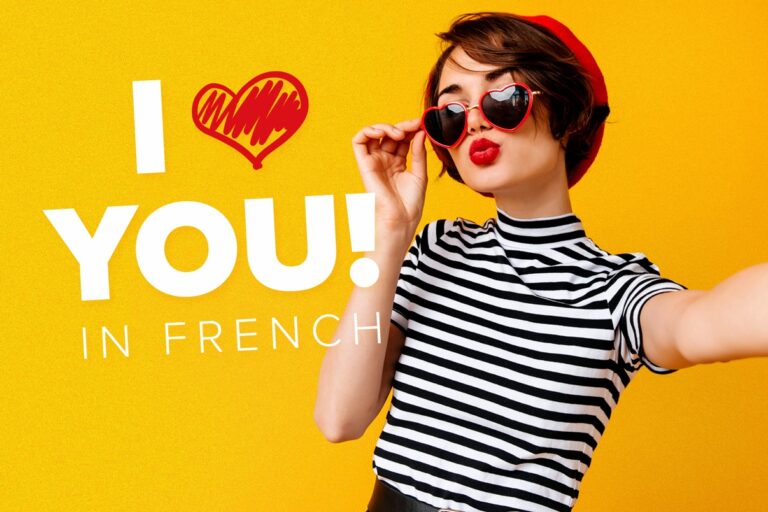How and When to Use Gerunds in French

The gerund is a verb form which usually functions as a noun. While English uses the “-ing” form for multiple functions, French employs a unique structure—en + present participle—to express simultaneity, causation or even the manner of an action.
I’ll guide you through the rules for forming and using the French gerund, highlighting its differences from English and providing practical examples. Soon you’ll be ready to incorporate the gerund into your own French conversations.
Download: This blog post is available as a convenient and portable PDF that you can take anywhere. Click here to get a copy. (Download)
What is a Gerund?
Similar to how -ing verbs (eating, walking, driving, etc.) are used in English, the French gerund (en + present participle, as in en mangeant , or “eating” and en dormant , or “sleeping”) offers French speakers a way of modifying the present participle of a verb to express simultaneity and causation.
“He spoke while eating.”
“He learns French by watching French films.”
These are just two examples of sentences in which the French gerund would be used.
The French –ant (present participle) ending is somewhat common, but its use is more restricted than that of the English -ing.
In English, we use the present participle to explain what we are, were or will be doing all the time. In French, however, the present participle can never be used to express those simple “I am/was/will be doing ____” sentences.
For example, in English, we say:
- “I am sleeping.”
- “I was sleeping.”
- “I will be sleeping.”
Those English examples use the English present participle, -ing. In French, however, –ant cannot be used in the same way. You can’t say Je suis dormant; it’s just not proper French. Rather, to express those English sentences in French, you would say, respectively:
In other words, you would conjugate the verb dormir accordingly for each tense that you want to express (present, past and future).
One common use of the French present participle, as you may have already guessed, is the gerund. As we already mentioned, it’s formed using the French present participle (-ant) preceded by en in order to show cause and effect and describe two actions happening at the same time.
Now that you have a basic idea of French grammar and gerunds, let’s learn some more about forming the gerund in French!
How Do You Form the French Gerund?
You form the French gerund by adding en + the present participle of a verb. The present participle is formed by taking the nous form of the verb in the present tense, dropping its ending and adding –ant. Here are a few examples:
| Base Form of the Verb | Nous Form of the Verb (Present Tense) | Gerund | Example Sentence |
|---|---|---|---|
| dormir
(to sleep) | nous dormons
(we sleep) | en dormant
(while sleeping) | Joséphine rêve en dormant.
(Joséphine dreams while sleeping.) |
| manger
(to eat) | nous mangeons
(we eat) | en mangeant
(while eating) | Joséphine parle en mangeant.
(Joséphine talks while eating.) |
| écouter
(to listen) | nous écoutons
(we listen) | en écoutant
(while listening) | Joséphine étudie en écoutant de la musique.
(Joséphine studies while listening to music.) |
Tout en can be used in place of en for emphasis. For example, if Joséphine, who we mentioned earlier, is a very chatty person, we could say:
Joséphine parle tout en mangeant ! (Joséphine talks even while eating!)
The gerund is typically placed at the end of the sentence, but it can be seen at the beginning of a sentence as well. For example:
Tout en mangeant, elle parle ! (Even while eating, she talks!)
When using the French gerund, always pay special attention to who is performing the actions discussed in the sentence. Otherwise, you could cause some misunderstandings.
The French gerund is used when there are two verbs, both performed by the same subject.
- In Joséphine étudie en écoutant de la musique (“Joséphine studies while listening to music”), the two verbs are étudier and écouter , but both are performed by Joséphine.
- If you were to say, En marchant, les enfants parlent avec leur père au téléphone , it’s implied that the children are the ones doing the walking and the talking (“While walking, the children talk with their father on the telephone.”)
- However, if you were to say, En marchant, le père parle avec ses enfants au téléphone , it implies that the father is the one doing both the walking and the talking (“While walking, the father talks with his children on the telephone.”)
FluentU takes authentic videos—like music videos, movie trailers, news and inspiring talks—and turns them into personalized language learning lessons.
You can try FluentU for free for 2 weeks. Check out the website or download the iOS app or Android app.
P.S. Click here to take advantage of our current sale! (Expires at the end of this month.)
When Do You Use the Gerund in French?
The closest English-language equivalents to indicate the use of the French gerund are “while,” “because”/“by” and “upon.”
“While”
When expressing simultaneity, the French gerund is equivalent to the English “while.”
Elle boit du thé en lisant un livre. (She drinks tea while (simultaneously) reading a book.)
The subject of our sentence is sipping a nice, relaxing cup of tea, while simultaneously reading her favorite book. She is one person performing two actions that are happening at the same time. So, we can use the French gerund to express this.
“Because”/”by”
When describing causation that expresses the manner by which something happened or by which some event came to be, it’s equivalent to the English “because” or “by.”
Le maladroit a trébuché en dansant. (The clumsy person tripped while/because he was dancing.)
The clumsy person tripped because of his dancing. His dancing was the cause of his fall, and by using the French gerund we can express this causation.
Paul apprend le français en regardant des films français. (Paul is learning French by watching French films.)
In the example above, the films are the means by which Paul is going to improve his language abilities. “By” watching the films, en regardant des films français , Paul will gradually improve his listening comprehension skills.
“Upon”
When describing causation that expresses the moment at which something happened, it’s equivalent to the English “upon.”
J’ai crié en tombant de l’échelle. (I cried out when/upon/at the moment when/because I fell off the ladder.)
Falling off a ladder, down the stairs or even tripping causes the average person to let out a small (or big and dramatic) cry. Upon falling, you let out the vocalization. En tombant , “upon falling,” you let out a cry.
(And just a friendly reminder once again that you never use the French present participle to express simple statements of what someone is doing, like “I am running” or “He is walking,” as we would in English. We have specific French grammatical tenses for that, and translating literally from English into a bad French sentence like, “Je suis courant”—literally, “I. Am. Running”—is more than awkward: it’s not a grammatically-correct statement in French!)
And there you have it: A basic introduction to the French gerund!
Try incorporating the gerund into your next conversation (maybe at the next event at your local Alliance Française?).
For further practice, it might help to see French gerunds in action. You can check out French authentic media featuring realistic conversations, such as novels, TV shows or movies. This kind of content can provide helpful examples of when the gerund comes into play.
Some language learning programs can help you review the workings of gerunds and French grammar as a whole. They can do so while offering tools to aid your understanding. One example is FluentU, which teaches with authentic French videos.
FluentU takes authentic videos—like music videos, movie trailers, news and inspiring talks—and turns them into personalized language learning lessons.
You can try FluentU for free for 2 weeks. Check out the website or download the iOS app or Android app.
P.S. Click here to take advantage of our current sale! (Expires at the end of this month.)
It might also be useful to have some French grammar rule-books for reference. Two excellent resources you can use are “English Grammar for Students of French,” which teaches French grammar by comparing it to English grammar, and the beginner-friendly “French Grammar.”
Before you know it, you’ll be a pro at using and understanding everything from en dormant to en mangeant to en anything-ant in between!
Download: This blog post is available as a convenient and portable PDF that you can take anywhere. Click here to get a copy. (Download)
And One More Thing...
If you like learning French at your own pace and from the comfort of your device, I have to tell you about FluentU.
FluentU makes it easier (and way more fun) to learn French by making real content like movies and series accessible to learners. You can check out FluentU's curated video library, or bring our learning tools directly to Netflix or YouTube with the FluentU Chrome extension.
One of the features I find most helpful is the interactive captions—you can tap on any word to see its meaning, an image, pronunciation, and other examples from different contexts. It’s a great way to pick up French vocab without having to pause and look things up separately.
FluentU also helps reinforce what you’ve learned with personalized quizzes. You can swipe through extra examples and complete engaging exercises that adapt to your progress. You'll get extra practice with the words you find more challenging and even be reminded you when it’s time to review!
You can use FluentU on your computer, tablet, or phone with our app for Apple or Android devices. Click here to take advantage of our current sale! (Expires at the end of this month.)











